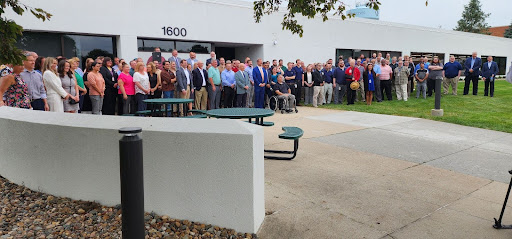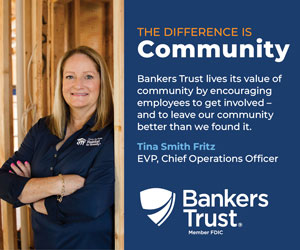Mediacom exec explains role of new network operations center

Gigi Wood Jun 18, 2025 | 5:08 pm
7 min read time
1,741 wordsAll Latest News, Innovation and Entrepreneurship
Mediacom Communications has opened its newest network operations center, completing a multi-year, $15 million investment in West Des Moines.
Dozens of employees gathered at the company’s 1600 36th St. facility in West Des Moines near Valley West Mall on Tuesday to celebrate the Hybrid Fiber Coax Network Operations System’s completion. The facility is now fully operational.
Mediacom provides high-speed broadband, video, phone and mobile services to 1 million homes and businesses in Iowa and more than 3 million nationally.
The new facility, referred to as the NOC, houses the technicians and personnel who monitor the health of the company’s 22-state network. In Iowa, Mediacom employs 1,184 people, with 465 of those in West Des Moines. The NOC will house 150 of those employees, including network engineers, technical operations staff and support personnel.
The facility also monitors business and enterprise customers, several data centers, cellular sites and local venues such as the Iowa Events Center in Des Moines, Xtream Arena in Coralville and Mediacom Stadium, home to Drake soccer and the Des Moines Public Schools athletic programs.
NOC personnel are equipped to proactively route around external network congestion or outages, helping ensure uninterrupted service for customers, through its 877,000 miles of fiber and 50,000 miles of coaxial cable. Upgrades to service have led to a 35% reduction in service calls and 63% drop in repair calls, officials said.
“We run one of the top five networks in the United States. It starts from New York City and [extends] to Silicon Valley,” J.R. Walden, senior vice president of technology and chief technology officer at Mediacom, said at Tuesday’s ribbon cutting. “We’re the backbone of most mobile carriers in the Midwest and that’s in addition to all the residential services we offer and all the upgrades we’re doing for the 10G platform.”
After the ribbon cutting, we talked with Steve Purcell, group vice president of Mediacom’s Capital region, about the significance of the new NOC facility. While much of the country is still adapting to 4G and 5G connectivity, companies like Mediacom are preparing for 10G. To achieve 10G, several factors will need to be in place, such as DOCSIS 3.1, a technology that allows for higher upload and download speeds to accommodate high-quality video, online gaming, video conferencing and other applications. Mediacom is currently building the infrastructure that will make 10G speeds possible in the future.
Purcell’s responses have been lightly edited for clarity and length.
Can you explain the significance of this facility and what it means to Central Iowa, and what end users and businesses will experience with these changes?
The NOC here does a couple things. Part of our business is residential, it’s a large part. But on the commercial side, we do a lot of enterprise. We’re consistently monitoring the network and working with third parties that we have connection points with [or our employees], to try to see connection and network problems before they happen. The goal is to be more proactive than reactive. If they see an area of the network where light levels are looking a little low, and customers are experiencing an issue, they can let us know, so we can get a team out there, and then we can run through that line and see what the issue is. The goal is to try to prevent a lot of outages. We do 571 cell towers; most of that capability is because we built fiber to the towers for them, and then they take it off that way. The key is, it’s 22 states, too. We’re in Central Iowa, but it’s 22 states, and it’s our commitment to Iowa. One third of our company is here, so the goal is to continue to support a strong local workforce in Central Iowa, but one that can take care of all of our customers across the country.
Certainly Mediacom was monitoring its network before this facility was built. What does this facility allow you to do that you couldn’t do before?
In the old NOC, we had some large TVs up on a wall so personnel could look at the network and see if there were any network issues. Now, you’ll see they each have four monitors so they can all have that directly at their desk in order to monitor it. You see how wide and open the space is now, so it’s a lot easier for them to be able to look, see if there are issues and respond to issues. And it’s a nice work facility we’ve created, so that will help when it comes to the morale and positivity of our employee base.
J.R. Walden mentioned the 10G platform. Can you talk about that in terms of the next generation of connectivity for Mediacom?
10G is a new technology. Using DOCSIS 3.1 gives us capabilities to go to DOCSIS 4.0 when that’s available (DOCSIS 4.0 will be required to achieve 10G speeds). West Des Moines is a good example. We completed the upgrade to the 10G platform in West Des Moines two years ago, and that upgrade to the network allows us to deliver 2-gigabits-by-1-gigabit, so 1-by-1 symmetrical (upload and download speeds are identical, at 1 gigabit each), and 2 gigs on the 3.1 modem. DOCSIS 4.0 modems will allow us to expand that speed.
West Des Moines is done with its network upgrade to the multi-gig platform. Des Moines is about 75% complete; the city of Des Moines will be done probably by the end of August. Then we’ll start each of the suburbs. We’ll start with Ankeny and Indianola, and then we’ll work through the rest of it; hopefully by the end of 2026 we’ll have them done. Our goal is to, by the end of next year, to have 1 million of our homes covered with 10G. We’ll upgrade about 500,000 to 600,000 homes each year until we get those completed.
This seems to be a win for economic development in Central Iowa. Can you help explain to companies considering a move to Iowa what they can expect as far as connectivity and network reliability?
Our reliability is 99.999% from a network perspective. We have so much fiber in our areas. We are a fiber company, we’re probably 98% to 99% fiber in the residential world. We use coaxial to finish that run, and that’s where the DOCSIS comes into play. It allows us to do 2.1 gigabits.
When we complete the overall upgrade, it will have the ability to go to 10-gigs-by-10-gigs through the network that we have. We’ll be exchanging from 1.2 [gigahertz] to 1.8 here.
The design will be completed, the testing will be done. We’ll begin using that format in these systems, too. 1.8 is what will really provide us with 10-gigs-by-10-gig symmetrical, and in the long run, they think possibly 40-gigs-by-40-gigs with that same network processing.
The key thing on that is we’re going to focus on delivering product reliabilities. As we mentioned, West Des Moines, we got done. Our household visits dropped by 35%, our actual network items repairs that we had to go out on dropped by 63%, so reliability is really spiking as you change out all the nodes, all the active devices. Right now we can deal with existing modems, which is good, so we don’t have to interrupt the household that much, or even the business.
A lot of Mediacom employees are here today. Can you talk a little about the workplace culture Mediacom tries to create?
One thing is, something new is always great. Our goal is to try to create an environment that employees want to come work for. We talk about Mediacom being a family, but it comes from the core. [Mediacom founder and CEO] Rocco Commisso has done his best to try to take care of all of our employees. We try to make sure we take care of them. We’re not going to leave anybody stranded in a [negative] situation. That’s the culture that you’re looking at, that we’re trying to create, is a group of folks that enjoy coming to work, doing what they’re doing, and our goal is to give them a lot of respect, because everybody’s got an important piece of this puzzle in this machine and I think you’ve seen exactly that. They’re very happy that we’re investing in them, as well and not taking jobs away. We’re moving jobs in and trying to increase as needed.
What keeps Mediacom in Iowa when some companies across the country are moving to different states?
It’s our commitment. Our commitment has always been to take care of the small systems. Des Moines is our largest operating system in the company.
When Rocco originally purchased this back in 2001, we did a full map of the state of Iowa and said, ‘What’s the cost going to be to upgrade this network to begin providing broadband services at the higher levels?’ That made sense on a statewide level. So we took 300 communities in Iowa and now they’re all tied together in one fiber network. It would have been very easy to just say, ‘No, Leon, Iowa, it’s too expensive to get to you,’ and we didn’t do that. Rocco didn’t do that. Our employees know that is part of the story, that we’re here to try to make an impact, to try to make a difference.
You’ll see it like with the Des Moines Mediacom Stadium, what a facility. We worked with Drake and with the schools to see what we needed to do to get that built, because that’s very important to the kids who didn’t have a super nice field to play on. Now they’ve got one to do soccer and football on. So I think that is part of the employees’ happiness is just making sure we take care of them, and making sure we take care of our customers.
Is there anything else you want the business community to know?
The key thing is the fiber availability. We do 10-gig networks all over the place. We’ve got school districts that have 10-gig networks. We’re very capable of doing that.
Whether it’s a manufacturing or technology-based development project we’ve got the availability around whatever level of pipe they want as far as bandwidth, from a fiber perspective. I don’t know for sure if a lot of people know that we’re in that marketplace, and we’ve got so much network built out that we’re pretty close to most anything they’re building.

Gigi Wood
Gigi Wood is a senior staff writer at Business Record. She covers economic development, government policy and law, agriculture, energy, and manufacturing.










